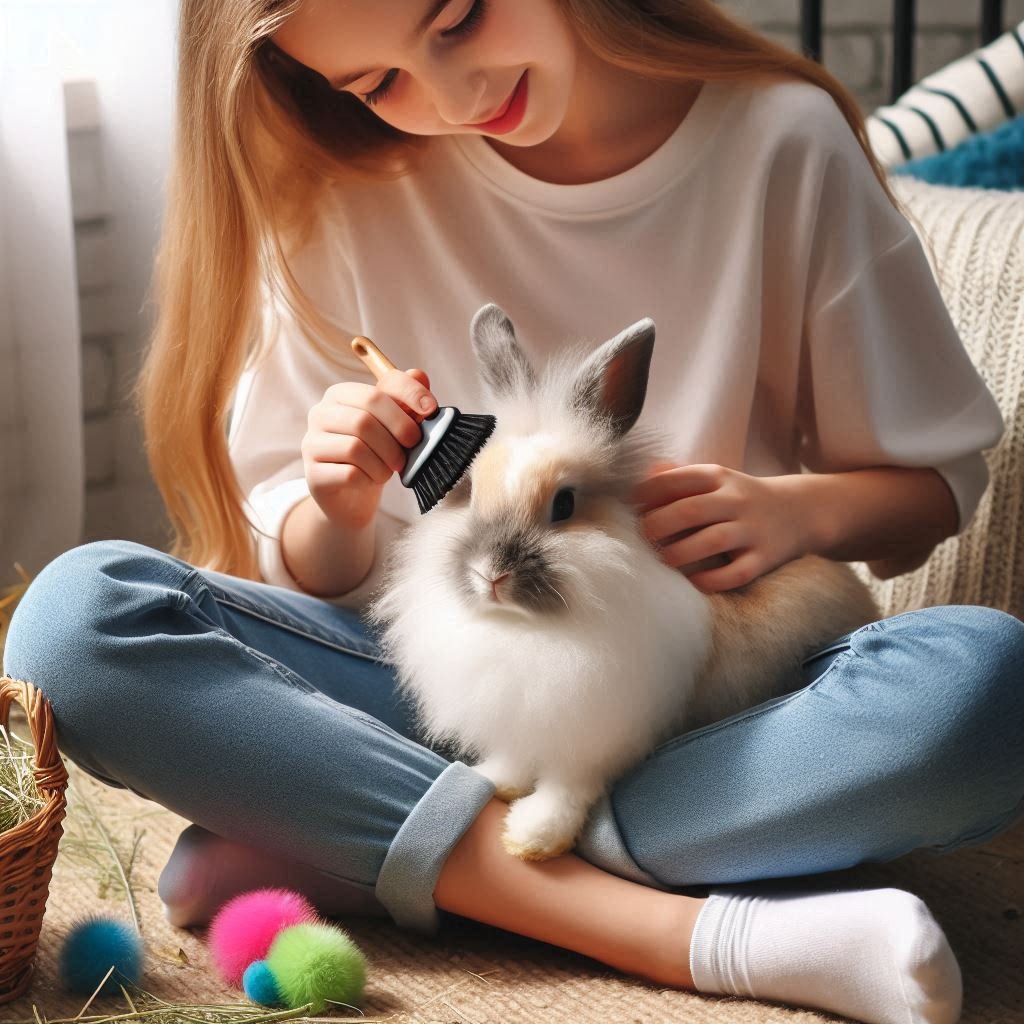Owning a pet rabbit can bring immense joy. They’re cute, fluffy, and surprisingly full of personality! But, unlike a dog or a cat, rabbits have their own unique needs that might catch a first-time owner off guard. So if you’re thinking of adopting one of these adorable furballs (or you already have one hopping around your house), buckle up! This guide will help you provide the best possible care for your new little friend.
1. Choosing the Right Breed: Not All Rabbits Are the Same
Before we dive into the daily care routine, it’s essential to know that rabbits come in various breeds, each with its own temperament, size, and care needs. Some rabbits are more playful, while others are calm and cuddly. The size of your rabbit will also dictate how much space you’ll need to provide.
Here’s a quick comparison of some popular rabbit breeds:
| Breed | Size | Personality | Special Notes |
|---|---|---|---|
| Mini Rex | Small (3.5–4.5 lbs) | Friendly, curious | Low-maintenance fur |
| Holland Lop | Small (2–4 lbs) | Playful, energetic | Needs a lot of exercise |
| Flemish Giant | Large (up to 20 lbs) | Gentle, calm | Requires more space, large appetite |
| Lionhead | Small (2.5–3.5 lbs) | Friendly, social | Needs regular grooming |
Pro tip: If you’re just starting out, a smaller breed like the Mini Rex or Holland Lop might be easier to manage than a Flemish Giant. Trust me, a 20-pound rabbit is a lot to handle!
2. Housing: Creating a Comfortable Living Space
Let’s face it—rabbits don’t just need a cage; they need a palace. Well, maybe not an actual palace, but they do need ample space to hop around. A cramped cage will make them frustrated and even lead to health issues.
Here’s how to set up the perfect home for your bunny:
Indoor vs. Outdoor
- Indoor: Many rabbit owners prefer to keep their rabbits indoors for better protection against predators, harsh weather, and loneliness. You can set up a rabbit-proofed area in your home, or keep them in a large pen or hutch inside.
- Outdoor: If you choose to keep your rabbit outside, make sure the hutch is safe, secure, and weatherproof. Include a sheltered area to protect them from rain, wind, and extreme temperatures.
The Hutch Essentials
- Size: Ideally, the hutch or pen should be at least four times the size of your rabbit. Your bunny should have enough space to hop around, stretch, and stand up on its hind legs.
- Flooring: Avoid wire flooring, as it can hurt their sensitive feet. Opt for solid flooring with soft bedding, like hay, straw, or fleece blankets.
- Litter Box: Yes, rabbits can be litter-trained! Use a simple litter box filled with rabbit-safe litter (never clay-based cat litter). Place it in a corner where your rabbit naturally tends to do its business.
3. Diet: Keeping Your Rabbit Healthy and Happy
If you’ve ever seen a rabbit chew away on a carrot, you might think they can survive on vegetables alone. Not so fast! A rabbit’s diet needs to be balanced to keep them healthy and avoid serious digestive problems.
Here’s a breakdown of the perfect rabbit diet:
- Hay: This should make up around 80% of their diet. Timothy hay or orchard grass is best for adult rabbits. Hay aids in digestion and keeps their teeth healthy (rabbits’ teeth never stop growing!).
- Fresh Vegetables: Leafy greens like romaine lettuce, cilantro, and parsley are rabbit favorites. Avoid iceberg lettuce as it has little nutritional value. A cup of fresh veggies per 2 lbs of body weight per day is a good rule of thumb.
- Pellets: Rabbit-specific pellets can be given, but in moderation. About ¼ cup per 5 lbs of body weight is sufficient. Too many pellets can lead to weight gain.
- Fresh Water: Always provide unlimited access to fresh water. Use a water bottle or a heavy dish (they love to tip things over).
- Treats: Rabbits have a sweet tooth, but sugary treats should be kept to a minimum. Fruits like apples, bananas, and strawberries can be given in small amounts as a treat. Just remember—everything in moderation!
4. Exercise and Play: Keep That Bunny Busy
Rabbits are active creatures that love to play and explore. Without proper exercise, they can become bored, overweight, and even develop behavioral issues.
Daily Exercise
Allow your rabbit out of their hutch for at least 3–4 hours per day to roam and hop around. If they’re indoors, make sure the area is rabbit-proofed (more on that later). For outdoor rabbits, a secure run or fenced area is perfect for exercise.
Toys
Yes, rabbits need toys too! They love to chew, toss, and dig. Here are some easy, budget-friendly toy ideas:
- Cardboard boxes (rabbits love to hide and chew on them)
- Untreated wood blocks or sticks
- Paper towel rolls stuffed with hay
- Willow balls
5. Grooming: Keeping That Fur Fluffy and Fresh
Depending on the breed, grooming can range from minimal to high maintenance. Even short-haired rabbits need a good brushing to prevent hairballs.
Brushing
- Short-haired breeds: Brush them once a week.
- Long-haired breeds (like Lionheads): Brush them daily to prevent matting.
Rabbits are clean animals, and they’ll groom themselves like cats. However, during shedding season, they may ingest more hair than usual, which can cause digestive blockages. Regular brushing will help reduce this risk.
Nail Trimming
Rabbit nails grow continuously, so you’ll need to trim them about once a month. If you’re nervous about doing this yourself, your vet or a local groomer can do it for you.
6. Health Care: Recognizing Common Rabbit Illnesses
Rabbits are prey animals, so they naturally hide any signs of illness. This can make it tricky to know when something’s wrong. Regular vet check-ups and keen observation will help keep your rabbit healthy.
Signs of Illness to Watch For:
- Loss of Appetite: If your rabbit stops eating, it’s a red flag.
- Lethargy: A normally active rabbit suddenly becoming sluggish.
- Runny Eyes or Nose: Could indicate a respiratory infection.
- Teeth Grinding: Loud grinding can be a sign of pain.
Regular Vet Visits
Find a vet who specializes in exotic pets or rabbits specifically. Make sure your rabbit is spayed or neutered, as this can prevent health issues like uterine cancer in females.
7. Socialization and Bonding: How to Be Your Rabbit’s Best Friend
Rabbits are social animals. They love company, whether it’s another rabbit or you! Bonding with your rabbit can take some time, but it’s worth the effort.
How to Bond with Your Rabbit
- Patience is Key: Some rabbits are shy at first. Sit quietly near them and let them come to you.
- Hand Feeding: Offer them treats from your hand to build trust.
- Gentle Petting: Most rabbits enjoy being stroked on their head and back, but avoid touching their feet and belly (they hate that!).
- Playtime: Get on the floor and engage with their toys. A happy rabbit might even do a “binky” – a joyful leap into the air.
8. Rabbit-Proofing Your Home: No More Chewed Cables
Rabbits are notorious chewers, and your home might look like a buffet to them. To keep both your rabbit and your belongings safe, it’s essential to rabbit-proof any areas they’ll have access to.
Here’s how:
- Cover Cables: Use protective covers or hide them behind furniture.
- Block Off Dangerous Areas: Use baby gates or exercise pens to restrict access to places they shouldn’t go.
- Provide Safe Chew Toys: To satisfy their urge to gnaw, give them plenty of safe items to chew on like wooden blocks, hay mats, or cardboard.
Conclusion: A Happy, Healthy Rabbit Is Worth the Effort
Caring for a rabbit isn’t just about feeding them and cleaning their cage. It’s about understanding their needs, offering them plenty of attention, and ensuring they live in a safe, stimulating environment. With proper care, your rabbit will thrive and be a joyful part of your life for many years to come.
Now, go forth and enjoy your bunny adventures! Just remember, the more you give your rabbit in terms of love and care, the more they’ll hop their way into your heart.


